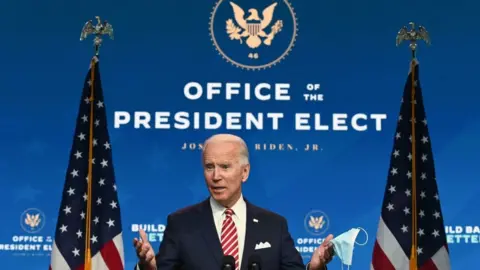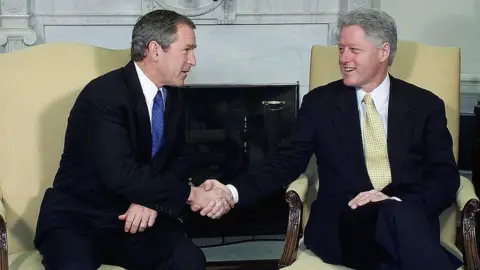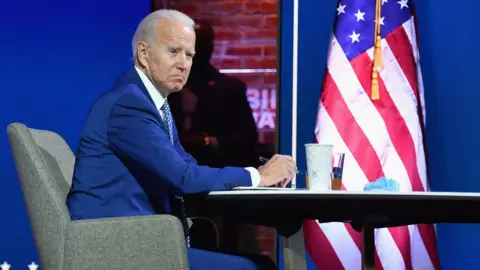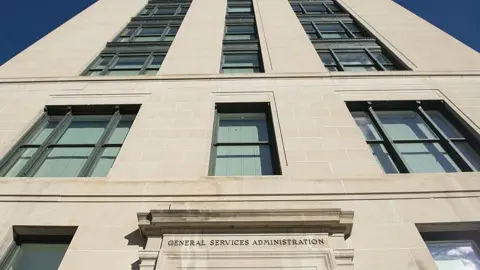US election 2020: What is the presidential transition?
 Getty Images
Getty ImagesPresident Trump has yet to concede to Joe Biden but has accepted that the formal transition process should begin, even as his team's legal challenges continue.
So what is involved in the transition and why is it so important?

What is the transition?
It's the handover of important information and duties from one administration to the next - ensuring the president-elect and their team are up-to-speed when they get to the White House.
The incoming administration is assisted by a government agency known as the General Services Administration (GSA), which provides funding and helps with things like office space, equipment, and technology.
A transition typically lasts about 11 weeks, normally from when it's clear who the winner is, up to 20 January when the next president officially takes over.
It's not just one job that's being handed over - the new president has to fill around 4,000 political positions, according to the Center for Presidential Transition.

What happens during the transition period?
Three main things take place - staffing, briefings, and organising the president-elect's packed schedule.
Once the handover officially begins, it's run by the president-elect's transition team which has been preparing throughout the campaign.
One of the most important elements is the daily security briefing.
All major presidential candidates receive some national security information before the election, but these briefings are not as frequent or detailed as the ones received by the president-elect.
Mr Biden will now get daily briefings with classified US intelligence information, ensuring the new administration is prepared for anything that might come its way.
 Getty Images
Getty ImagesThe commission into the 11 September attacks carried out in 2001 found that the delayed transition after the 2000 election could have contributed to the then Bush administration's failure to prevent them.
The incoming administration is also allocated additional office space and equipment as it prepares for life in the White House.
Meetings would usually be arranged with the current members of government agencies to help with staffing and policy changes, and key team members will often shadow outgoing staff to prepare for their new roles.
Mr Biden has already begun appointing key staff members, but the transition process helps the heads of each government agency identify the roles they need to fill.
Of the 4,000 political positions the incoming administration fills, about 1,200 require Senate confirmation - with the government helping to provide background checks during the transition.
This year, there's also the coronavirus pandemic, and Mr Biden has said he wants more contact with top health agency officials and access to full public health information.
 Getty Images
Getty ImagesAs well as meetings with government officials, the transition team usually co-ordinates with the State Department to organise calls between the president-elect and foreign leaders.
Until now, Mr Biden's team has had to communicate through unofficial channels. It will now be able to use government e-mail and have access to secure channels.
Following previous elections, the president-elect and their spouse have been given a tour of the White House and asked about their preferred decor as they prepare to move in - although this is more of a convention than a legal requirement.

Why has the transition been delayed?
It usually starts when a letter is issued by the GSA recognising who the next president is.
But this year, the GSA had refused to issue a letter recognising Mr Biden as the winner until 23 November - almost three weeks after the election was held.
 Getty Images
Getty ImagesThis blocked the release of funds and other resources for the Biden team.
The legal requirements on when a transition has to begin are vague, giving the Trump administration some leeway to seek a delay as it disputes the election result.
Under US law, the GSA has to trigger the transition once there's an "apparent winner", although there's no firm date set for when this has to be.
It's been delayed before - in 2000 the transition period was half its usual length as the election result was being contested in court, although that was a much tighter race than this year.
By contrast, Mr Trump was recognised as the winner by the GSA the day after the 2016 election - long before the results were made official - and he visited President Obama in the White House the day after that.

Who pays for all of this?
The cost of the transition is covered by a combination of government money and private funds.
Once the president-elect is recognised by the GSA, about $7m of federal funding is released.
This is usually topped up by funds raised by the president-elect.
The New York Times reported that Mr Biden had raised around $7m for his transition effort in early November, and he has since appealed for further funds from his supporters.
This all goes towards paying the millions of dollars of expenses built up by the presidential transition.




